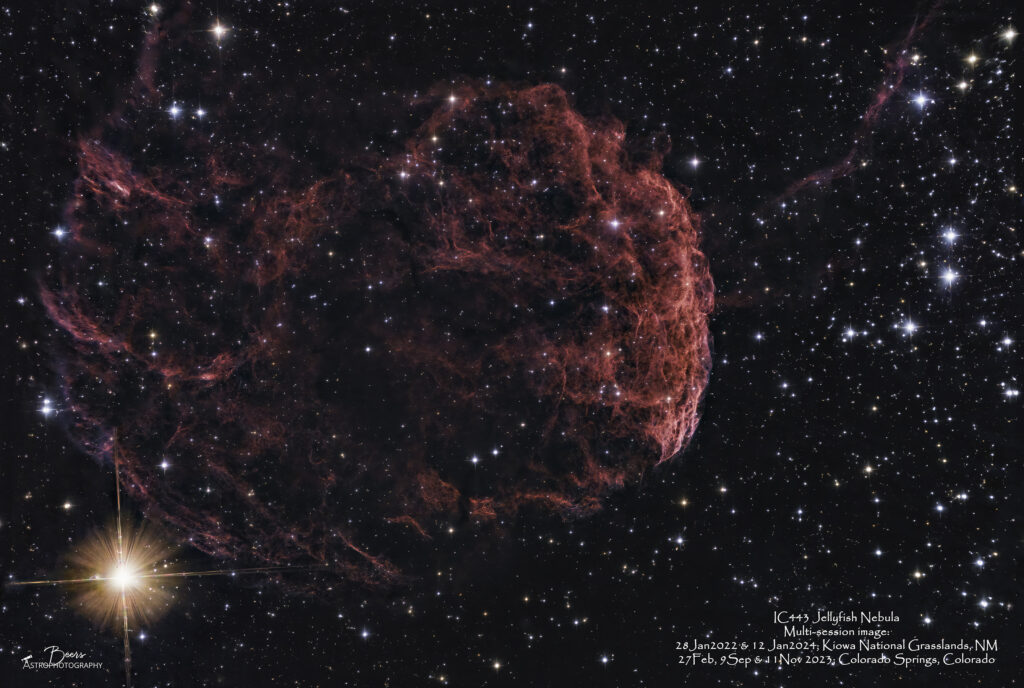In keeping with the trend I started in 2023 of creating images by stacking multiple session’s data. I created the image below from five sessions’ data collected over an almost two-year period. I also decided to experiment with different APP stacking techniques. I stacked data from five sessions using two different methods. The data were collected: In 2022 on 28Jan2022 with Big Bertha and the Canon EOS Ra (RaBB) in the dark skies of the Kiowa National Grasslands, NM. In 2023 on 7Feb2023 with the ZWO ASI2400MC, Big Zeus, and the LeX filter; 9Sep2023 ZWO ASI2400MC, Big Bertha, and the LeX filter; and 11Nov2023 with the ZWO ASI2400MC, Big Bertha, and the LPro filter. All the 2023 sessions were captured from the front patio of our home in Colorado Springs, Colorado. In 2024, on 12Jan2024 with Big Bertha on the RST-300mount and the ASI2400MC from the Kiowa National Grassland’s Mills Canyon Rim Campground.

Stacking experimentation
The stacking “experiment consisted of stacking as I usually do in Astro Pixel Processor – with all five sessions stacked together creating a single image. Then I experimented with Ann Chavtur’s method of using the Combine RGB Tool in APP to create an RGBHOO image.
The stacking “experiment” consisted of images created:
- 5session: Stacked all five sessions into a single image, using AAD algorithm, saved (to process by itself and use as RGB in combine tool)
- 3session: Stacked Kiowa and LPro sessions into a single image, using AAD algorithm, removed LP and saved (to process by itself (didn’t (yet!) and to use as RGB in Combine)
- 2session: Stacked LeX sessions into a single image, using HaOIII Color algorithm. Reran with HaExtract and OIIIExtract for Ha and OIII in RGBHOO Combine (was actually 3 sessions, because used both 5min and 10min from 7Feb2023 as separate sessions)
- 5session RGBHOO: Then closed and restarted APP and loaded the .FITS files to combine as light frames. Registered the .FITS files (deselect same camera and optics). Ran APP RGB Combine Tool (RGBHOO):
- Load 5session into RGB; Load 3session into RGB; Load 2session HaExtract into Hydrogen Alpha; Load 2session OIIIExtract into OIII (twice)
After finishing the APP stack/combine process, I removed the stars using Starnet++ and was then faced with the challenge of deciding which image to process. I had a hard time seeing/deciding upon the differences between the stacking methods. There were visible differences, but mostly in the overall tone, not in the details or colors of the image. When I focused on the difference between the 5-session stack and the same data used with the RGBHOO Combine Tool it seems as if the RGBHOO has more of a green tone and less brightness, whereas the 5-session stack has a blue tone and a slightly more brightness. So, I decided to move forward with processing the 5-session stack that was created using my normal stacking process. That processing (in Lightroom and Photoshop) produced the image shown above.
Take a look at the “rest of the story” of IC443 Jellyfish Nebula here: https://beersastrophotography.com/gallery/ic443-jellyfish-nebula/
